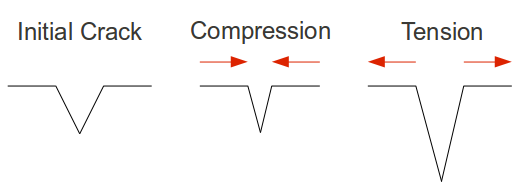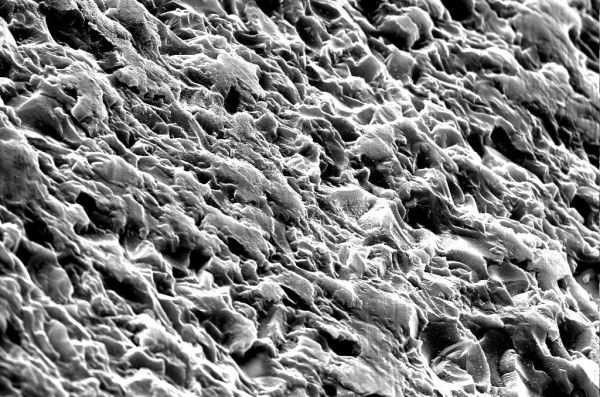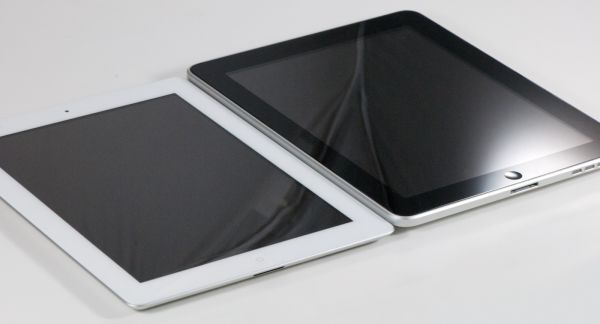The Apple iPad 2 Review
by Brian Klug, Anand Lal Shimpi & Vivek Gowri on March 19, 2011 8:01 PM ESTI asked a friend of mine, Alexander Miles, to write a bit about the properties of glass that really contribute to its overall strength after reading that the iPad 2's glass is 0.62 mm thick compared to 0.85 mm thick in the iPad 1. Hopefully this dispels some myths about glass strength and clarifies. Alex is a senior double majoring in Materials Science and Engineering and Optical Science and Engineering at the University of Arizona.
On the Strength of Glass
We usually think of things failing under compressive stress, being pushed inward from both sides until it they are crushed. Glass and ceramics, it turns out, are incredibly strong in compressive stress. Strictly by the numbers, a fire truck could be supported by a ceramic coffee cup underneath each tire, but only if the load was perfectly downward. Why then are glasses so fragile? This is because no situation causes only compressive stresses, and tensile stress (imagine pulling something from both ends) is what causes glasses to fail. One can think of tiny cracks inside the glass being pushed closed under compressive stress, but torn open under tensile stress.

A schematic illustration of crack behavior in brittle materials.
If you test the tensile strength of thousands of pieces of glass with identical processing and geometry, you will get thousands of different answers. This is markedly different from metals, where you will get nearly the same result every time. The reason being that glass and ceramic materials have a much lower fracture toughness, as much as 100 times smaller than that of a metal. Fracture toughness indicates how easily a crack can propagate, or to phrase it differently, how big a flaw will cause fracture for a given load. As the required load for normal flaw sizes in metals is enormous, metals typically do not fracture in the way glasses do. Metals usually fail in what is called plastic deformation, necking down then tearing away, long before fracture can occur. This plastic deformation is very predictable and follows the stress-strain curve for the given metal, whereas glasses are less predictable.
The question now is, how does the size of a piece of glass affect its behavior under tensile stress? It depends on the distribution of flaws within the material. If you strike a piece of glass with a hammer, a compressive stress is created right below the hammer, but a ring of tensile stress is also created around the spot you hit. You are essentially sampling the distribution of flaws, because if any of the flaws in the affected glass are big enough to widen with the stress you provided, they will rapidly propagate and the material will fracture. The stress field extends down into he material, so flaws in the volume can cause failure as well, though surface flaws are more consistently to blame as the stresses encountered there are almost always larger.

SEM image of a broken glass surface, (CC BY-NC-ND 2.0) attribution St Stev's flickr.
In glasses the distribution of failure stresses is described using Weibull statistics, giving a peak where most samples fail, and tails both on the high and low end where samples had abnormally high and low failure stresses respectively. The long and short of this is that consistently processed samples will have a more narrow distribution as the geometries are scaled down. This means that a thinner piece of glass will have fewer flaws in the bulk and far less likelihood of having a large enough flaw to cause catastrophic failure compared to a thicker piece of glass. The fact that the screens have a large aspect ratio, that is they are far thinner than they are wide or long, means that the effective stiffness will be different in the two directions. Taking this to an extreme, a very thin glass fiber is fairly flexible in bending, but very stiff axially, as its cross-section is so small that very few flaws are contained inside it. If one needs to break a glass fiber, a surface flaw is usually created by scratching it first.
| Approximate values for the strength of common soda lime glass in various conditions | |||||
| Condition | Tensile Strength (MPa) | ||||
| Theoretical Maximum (Flawless) | 9810 | ||||
| 3 Micron Fibers | 3330 | ||||
| Thin rods, fire-polished and acid etched | 3420 | ||||
| Thin rods, no special treatment | 690 | ||||
| Bulk, ion exchange tempered | 350 | ||||
| Bulk, thermally tempered | 300 | ||||
| Bulk, fire-polished and acid etched | 220 | ||||
| Bulk, no special treatment | 50 | ||||
In order to use glass screens on our devices, we would like it to be far tougher, where "tougher'' ideally means both more resistant to fracture as well as more resistant to scratching. There are two basic schemes used to strengthen glass: elimination of the surface flaws, and creation of compressive stress in the bulk of the glass. Eliminating the surface flaws by polishing, fire-polishing (heating them until surface tension flattens out the flaws), and acid-etching does indeed increase the strength, and drastically so. An increase in strength of up to one hundred times can result from such treatment, but is temporary as microscopic scratches from handling will quickly reduce the strength back to what it was before.
The second scheme for improving strength, introducing a compressive layer, works because existing compressive stress in the glass has to be overcome by the induced tensile stress before any cracks can propagate. To say it plainly, if you don't hit it hard enough with a hammer, it will not even see the type of stress that makes it fail. The down side to this method is that every force causes an equal and opposite force, meaning that a lot of compression at the surface causes tension at the center. As long as a crack does not reach the volume with the additional tensile stress imposed on it, the glass will hold together, but once it does it releases the energy kinetically and fails catastrophically (it explodes like a pumpkin with an M80 stuffed in it).
The way this layer is created varies based on the application. For car windshields, they are thermally tempered by chilling the outer surface while the center is still hot, as the surface remains solid while the center is still busy shrinking, which leaves the surface in compression. Similarly, coating the glass object in a second type of glass with a lower thermal expansion will cause the same effect, as the outer surface shrinks the center is shrinking faster. The multiple-glass approach has the additional benefit that cracks have difficultly moving from one type of glass to the next, leading Corning to produce some glasses with as many as 7 layers.
The final method, and most relevant to our discussion, is ion-exchange. Ion-exchange refers to removing small ions, like sodium, from the glass, and replacing them with larger ions like potassium, all at a temperature that prevents the structure of the glass from adjusting itself to these new bigger ions. The way this swap is actually done is by immersing the glass in a molten salt solution containing the ion we want to substitute in, and allowing it to diffuse in over time, while the smaller, more mobile, ion diffuses out. Depending upon the type of glass, the ions being exchanged, and the desired depth, this process can take as long as several days.
The iPad 2 and previous iPad both utilize Corning Gorilla Glass. This type of glass is an alkali-aluminosilicate, being primarily silica and aluminum with an alkali metal, along with other unspecified components mixed in to tweak its properties. The biggest benefit of alluminosilicate glasses, aside from being relatively tough to start with, is the fact that the rate of ion exchange is fairly high even at temperatures low enough that the structure cannot react, meaning it can be processed quickly and create deep protective layers in the glass. The iPad 2 has a modest reduction in the thickness of the glass (about 23% thinner, for those interested) compared to the first iPad, and the question of increased fracture risk has been posed. Given the identical surface quality between the two generations, the reduction of thickness should create no palpable change in toughness for the typical user. That is to say, a drop that would shatter the screen on the original iPad would likely do the same for the new model. That being said, several other design changes appear to account for the change, and might yield better performance in this department.
Where its predecessor used small metal clips to retain the glass screen, the current iteration uses a ring of adhesive around the entire perimeter that not only distributes the load around the glass and prevents scoring at the glass-metal interface, but better couples the stresses into the more compliant aluminum frame. Both of these measures should improve the performance; either way, drop-testing new electronics is generally not recommended.











189 Comments
View All Comments
shangshang - Sunday, March 20, 2011 - link
but if you enough fanatic hipsters, +1 device can become a primary fashion must-have.And it's not just yuppies. There are so many geeky engineers at my work place that have an iPad so they can just put it next to there desktop PCs. Worst, there are some managers who use an iPad right along side their laptops in meetings. Baffling to me. I can only chuck it down as fashionable. I mean it's the same reason women pay $2000 for an LV purse that most men would deem god ugly.
kasplat99 - Sunday, March 20, 2011 - link
Last fall there was a discussion of a limitation of 16GB on photos in the iPad.http://discussions.apple.com/thread.jspa?messageID...
I haven't been able to find out whether this was resolved with an iOS 4.x update or the problem persists. This probably is not a limitation of the camera connector kit itself, but rather the photos app, either for total number or data size of photos, but regardless it is a serious limitation if trying to use the iPad for photo work or backup on a long trip.
Testing should be done on 32GB or 64GB iPad if anyone wants to check on this.
BlendMe - Sunday, March 20, 2011 - link
While reading the section on the cameras and the camera UI, I was wondering if you couldn't have saved yourself 1/2 page of writing by just switching on rotation lock? I see that the rotating controls are annoying, but isn't that what the rotation lock switch is for? To keep the UI from rotating?dagamer34 - Sunday, March 20, 2011 - link
That's a pretty bad hack for a problem they should have realized themselves if they ever tried to take a picture with the iPad 2.BlendMe - Sunday, March 20, 2011 - link
How is that a hack? That's what the switch is for (unless you set it to be a mute switch). If you use it to lock the rotation in a browser it's considered a feature.Theoretically (I don't have an iPad 2 and won't be able to try one for at least a week) this switch should allow you to place the capture button on any side of the screen.
I'm kinda surprised Anand/Brian/Vivek didn't even mention it, given that most of their reviews are very thorough and in-depth.
Azethoth - Monday, March 21, 2011 - link
I second that notion. My default is to have rotation locked. I loves me some landscape mode and when reading with it flat it freaks out without some rotation discipline.Now that its on the external switch again there really is not much issue.
Still, it was a major UI oversight. I think they got "lucky" that Jobs was sick and didn't see that rubbish and chew someone a new one. Heck, even Gates would have noticed such UI incompetence.
Bosh - Sunday, March 20, 2011 - link
Yes, you can wait and wait and wait and...........WaltFrench - Sunday, March 20, 2011 - link
Aw, cut @geekfool a break: he's waiting because by then, Flash 10.3.0173 will actually have watchable 720 framerates on a quad-core Tegra.There's geek and there's geek. Perhaps geekfool has drunk the Adobe jizz bigtime. With that list of priorities, he's absolutely doing the right thing.
LauRoman - Sunday, March 20, 2011 - link
Great review but it doesn't hold a candle to Charlie Brooker's 3 and a half minute insightful dissection of the differences between the two devices.http://www.youtube.com/watch?v=qNSn6AtdSGM
kube - Sunday, March 20, 2011 - link
Great review.I have an iPad 1 and plan on upgrading.
The review says that the principal use is email and web-browsing. Like most my use focuses on a few uses. But the most important is reading.
1. books. I use the Kindle app most, but sometimes ibooks. I share lots of books with my daughter, who uses a kindle device. Ebooks have probably doubled my book reading.
2. journal articles. For me, this is revolutionary. I'm a scientist, and over the past decade journal articles have migrated from print to pdf. With applications like "good reader" and especially "papers", my reading experience has changed. Reading a journal article pdf off of a computer screen is a second-rate experience. Reading off of the ipad, for me, is as good or better than reading print. As pdf applications have matured, the ability to high-light or write notes on the pdfs has gotten better. Really terrific.
3. Other pdfs. Viewing pdfs of slide presentations or theses or other stuff is great.
4. Instapaper. Can't believe its legal. While saving standard web pages is nice, it really shines at saving things like extended magazine articles. Things like the NY Times book review or NY Review of books articles. Extremely comfortable reading experiences, and easy to share with friends via email.
Another comment. My college-student daughter has an 11-inch macbook air. Its her only computer and is a terrific device. it seems to be a better device for students. It overlaps the function of the iPad making it hard to justify both.